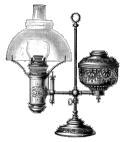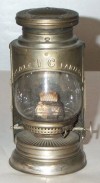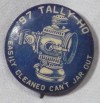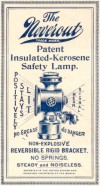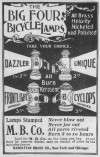The invention of the "modern" bicycle dates to the mid-1800's and earlier, depending upon which source you consult. The early versions were called velocipedes and were propelled by the rider "walking" while seated on the wheeled vehicle. Many of the early designs were of European origin, the products of French, German and English ingenuity. Over the years, various improvements were made including steering, pneumatic tires, pedals and cranks, suspensions, gears, and other safety features. By the late 1800's, the form of the bicycle would be as readily recognizable as those manufactured today.
As the bicycle gained popularity and became more affordable to the masses, so came the need for illumination for nighttime riding. They were most often fueled by kerosene or carbide/acetylene - our focus shall be on the former.
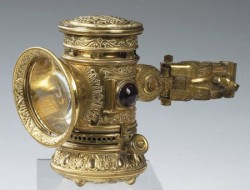 The ornate brass SEARCH LIGHT Bicycle Lamp
The ornate brass SEARCH LIGHT Bicycle Lamp
manufactured by The Bridgeport Brass Company.
Louis Hornberger's Pat. No. D28,080, Dec. 21, 1897. |
Bicycle lamps were manufactured by most, if not all, of the major American lamp makers -
Edward Miller & Company,
The Plume and Atwood Manufacturing Company,
The Matthews and Willard Manufacturing Company, The Hitchcock Lamp Company,
The Bridgeport Brass Company,
Bristol Brass and Clock, and certainly others. Many of the lantern makers made bicycle lamps as well - R.E. Dietz, Peter Gray, C.T. Ham, and The Rose Manufacturing Company, maker of the Neverout. English manufacturer Joseph Lucas & Sons of Birmingham, England produced a full line of bicycle lamps, as did Powell & Hammer and Henry Miller.
The basic, overall design of the bicycle lamps remained relatively standard. They consist of a lamp or lantern housing (most often brass and sometimes nickel-plated), removable fount and burner, front lens and reflector, and some type of bracket for attaching the lamp to the bicycle. Most have a convex lens on the front to focus and concentrate the light. On the back of the inside of the housing, there is often a polished metal reflector to increase light output. There are often green or red glass jewels on the side or back of the lamp which function as side (green) and rear (red) markers. You may find cotton wadding in the founts that was placed there to prevent the oil from sloshing around.
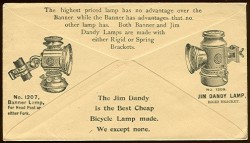 Plume and Atwood Mfg. Co. advertising cover
Plume and Atwood Mfg. Co. advertising cover
featuring the BANNER and JIM DANDY lamps
|
The bottom portion of the housing is vented to permit the intake of combustion air and top of the lamp is vented to dissipate heat and smoke. The brackets vary from fixed style mountings to more complex, multi-spring mechanisms designed to absorb shock. The lamps could be mounted to the front tube or on the fork, depending upon the type of bracket purchased. The SEARCH LIGHT above is shown with a rigid bracket, the UNIQUE below has a spring bracket.
Advertisements for bicycle lamps were commonly found in ladies magazines like Munsey's or The Cosmopolitan, trade journals and other publications of the period, especially in the late 1890's. The advertisement on the left from The Manhattan Brass Company features four models of bicycle lamps - the "Big Four" - DAZZLER, UNIQUE, FRONTLIGHT and CYCLOPS. Numerous patents were granted between the years of 1881 and the early 1900's. The hey-day of the kerosene bicycle lamp must have been during the years of 1896 through 1898 when nearly one hundred patents were granted.
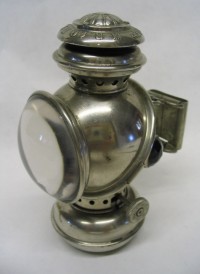 The UNIQUE Bicycle Lamp, nickel plated,
The UNIQUE Bicycle Lamp, nickel plated,
by The Manhattan Brass Company.
J.M. Herman's #578,564 - Mar. 9, 1897
And D29,535, October 25, 1898.
Photo courtesy of
Copake Auction Inc.
|
The most prolific American inventor of bicycle lamps appears to be
William C. Homan with nine U.S. patents, all assigned to Edward Miller & Company. The majority of Homan's patents were for improvements in lamp brackets.
Frank Rhind had six bicycle lamp patents, all assigned to The Bridgeport Brass Company. Three of his patent drawings depict variations of the SEARCH LIGHT (seen above). It should be noted that Frank Rhind had over eighty lighting patents over his illustrious career.
John W. Bragger of Watertown, New York, has four bicycle lamp patents to his credit, all assigned to The Hitchcock Lamp Company between 1895 and 1898. The Hitchcock bike lamp bears his name,
the BRAGGER, and is consistent with patent no. 597,385, issued on January 18, 1898. Bragger also patented the lamp made by Hitchcock known as THE HAPPY THOUGHT, October 1, 1895. Plume and Atwood's BANNER lamp, depicted on the left above, was patented by
Lewis J. Atwood on July 13, 1897. His invention received patent number 586,348. Atwood had one other bike lamp patent and like Rhind, was instrumental in the development of kerosene lighting, having had nearly seventy lighting patents to his credit.
See the
patent table below for a list of bicycle lamp patents.
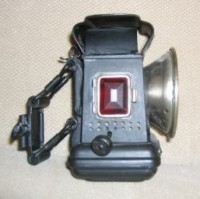 THE KINGLET, circa 1896
THE KINGLET, circa 1896
Joseph Lucas LTD, Birmingham, England
|
Bicycle lamps came in a plethora of models to fit all budgets. Some were plain and economical, like Plume and Atwood's JIM DANDY which sold for about a dollar and a half. Others like The Bridgeport Brass Company's SEARCH LIGHT, were top-of-the-line, highly ornate models with high price tags. The SEARCH LIGHT sold for four dollars a piece in an 1899 catalog, the most expensive of over a dozen lamps advertised. These expensive models were often outside the means of the common working-class man.
Sales and marketing schemes were abundant and widespread, based upon the number of advertisements surviving today. Manufacturer's claims included wind and weather proof housings, lights that "won't jar out" due to shock or vibration, ease of disassembly and cleaning, and other claims intended to increase sales and profits. Edward Miller even branched out to include
bicycle bells and a cyclometer - a device, like a vehicle odometer, to record the distance traveled.
Like everything else, the kerosene bicycle lamp faded into obscurity as it was replaced by safer and more modern battery operated lighting and dynamo-driven bicycle lighting systems.

| Patents for Kerosene and Carbide Bicycle Lamps, 1881-1909. |
| D31182 |
250483 |
252371 |
264955 |
307511 |
368355 |
373911 |
436528 |
| 467227 |
478776 |
480210 |
480661 |
499440 |
520658 |
529885 |
533719 |
| 539626 |
540296 |
540605 |
541172 |
547200 |
547201 |
551082 |
551084 |
| 554009 |
554044 |
554863 |
557394 |
558142 |
559946 |
560110 |
560338 |
| 562319 |
564882 |
565156 |
565272 |
570893 |
570894 |
573148 |
575327 |
| 575717 |
575779 |
576769 |
577155 |
577429 |
577967 |
578014 |
578451 |
| 578564 |
579593 |
580569 |
580757 |
581503 |
581991 |
582978 |
583534 |
| 584054 |
584358 |
584613 |
584614 |
584679 |
585609 |
585885 |
586000 |
| 586348 |
588115 |
588460 |
588904 |
589459 |
589588 |
589953 |
590911 |
| 590919 |
591108 |
593016 |
593281 |
593396 |
594264 |
594517 |
595191 |
| 595576 |
597385 |
597933 |
598490 |
599088 |
599149 |
599525 |
600447 |
| 606974 |
607162 |
607544 |
608097 |
608403 |
609192 |
609193 |
609222 |
| 609689 |
614315 |
615244 |
623606 |
624267 |
626001 |
635366 |
639434 |
| 639853 |
650211 |
650854 |
656480 |
656874 |
660639 |
680413 |
688926 |
| 689747 |
696854 |
914259 |
520659 |
add'l patents will be added as discovered |
| D = Design Patent, RE = Reissue of an earlier Patent |
To view any of the above patents, enter the number in the box below and select Query USPTO Database. This will take you to the specific patent images on the U.S. Patent & Trademark Office Database. Learn more about the USPTO here.

- If you can locate copies, there are two excellent articles on Bicycle Oil Lamps in The Rushlight. Part I is in Volume 51, No. 3, September 1985; Part II is in Volume 51, No. 4, December 1985.
 Bicycle Lamp & Lantern Patents
Bicycle Lamp & Lantern Patents